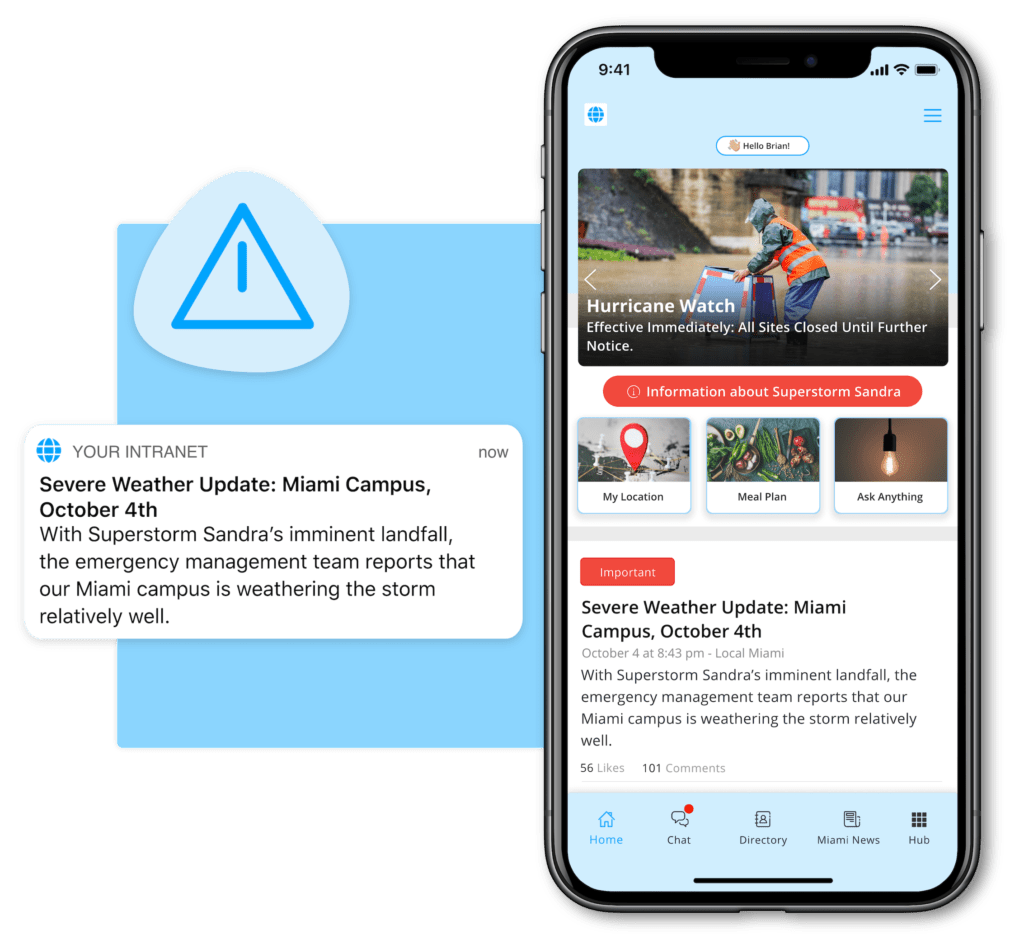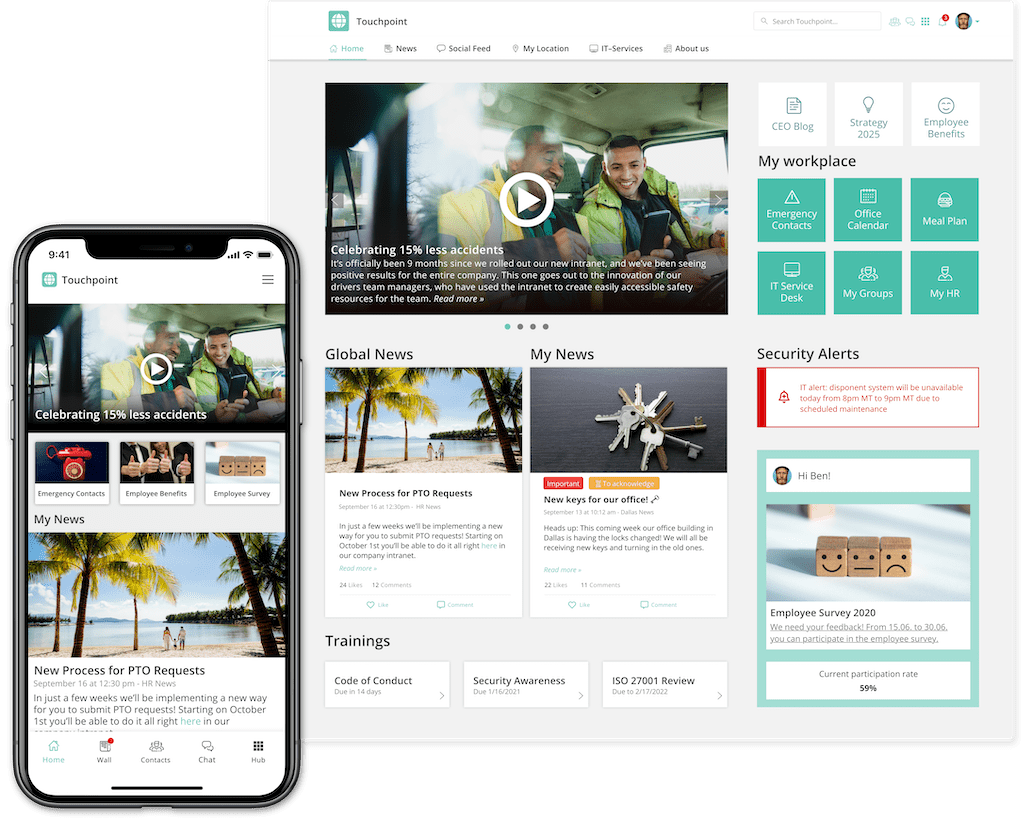Reach All Employees with the 8 Most Relevant Internal Communication Formats and Channels

Putting together an internal communications strategy isn’t easy. It must reach all employees, ideally at the optimal time and with the right message. And of course, it should feature content that is relevant and carry a memorable message. And these days, you have lots of internal communication formats and channels to choose from.
Sound complicated? Don’t feel discouraged — we’re here to help.
The main point to keep in mind is that there isn’t one correct way to spread messages within your organization. The channel and format you choose all depends on the message you’re communicating. For example, a more sensitive topic might be raised in a town hall where employees have the opportunity to ask questions. But a casual announcement about a holiday party might best be communicated in an email newsletter. Certain channels and formats are particularly well suited for specific use cases.
What makes for good internal communication formats?
Reach:
Around two billion people worldwide are non-desk workers. That’s 80% of the working population. They spend most of their working days on the factory floor, behind the counter, or at hospital bedsides.
Many of them lack access to company PCs and, as a result, can’t be reached like desk workers. It is especially important to provide these people with relevant information. The reach of your channels provides a clear metric for how effective your communication has been.
Real Time:
The speed at which we consume information and products has been constantly increasing in recent years. For example, shipping service providers offer express delivery, streaming services make entertainment instantly accessible, and our smartphones allow us to be online constantly. Receiving information and communicating in real time has become a must for internal communicators.
Is your internal communications channel capable of delivering important company news in minutes instead of hours or days? And is the content being communicated up-to-the-minute or is it already yesterday’s news?
Interaction:
Is your information flowing in only one direction or are there opportunities for real dialogue? Social media features such as likes, comments, and sharing are more-or-less expected these days. Current formats like pulse surveys that can be sent via email or placed on an intranet or employee app help solicit quick and consistent feedback.
They also support bottom-up interactions and enhance horizontal communication. Both are essential for increasing engagement and productivity in everyday work processes.
Analytics:
How many employees have received a particular message and how many have interacted with it? Finding out should be simple, but not all channels fulfill this requirement. Measuring the effect of internal communication is a must if the reach is intended to improve over time.
Storytelling:
Stories are a great way to share information and convey values. However, telling them effectively is much easier on some channels than others. Getting employees involved in your content creation can make this task a lot easier.
Rich Media:
Various media formats such as updated articles, current images, and especially insightful videos are a great way to create compelling stories. While simple posts are best for conveying unfiltered information, rich media posts are guaranteed to increase audience engagement.
Local Relevance:
The more relevant the news, the more it resonates with your audience. That’s why a discussion about corporate strategy on your employee app usually has fewer comments than the news about a new cafeteria. Balancing strategic communication with local content is the best way to establish a lively and relevant communication channel.
Cost:
The impact of internal communications on a company’s success is difficult to measure, but new tools are making measurement easier. That’s why it’s critical to start evaluating your communications for cost-effectiveness as soon as possible.
Learn how to get the budget you need for new communication channels here.
What are the 8 Most Relevant Internal Communication Channels?
1. Personal conversations
Our top communication channel is face-to-face conversations. What could be better than directly talking to each other? When it comes to communicating complex messages, in-person is ideal.
A conversation is interactive and immediate. One-on-one conversations have the greatest information density among communication channels. We can clearly perceive voice pitch as well as facial expressions and gestures. Emotions can be easily interpreted.
Things change, however, in virtual calls. The limited view of the other person via webcam doesn’t allow body language to be read in its entirety. The density of information decreases.
As an internal communicator, you should always ask yourself whether the benefit of a personal conversation outweighs the expense. IRL face-to-face meetings may require more time and travel. Is it worth taking the trip if participants are located at different offices?
Also, one-on-one-meetings don’t make much sense if you’re trying to communicate the same message to many employees. Unless you’re counting on a middle manager to spread your message, or hoping that grapevine communication will do the trick, the reach of one-on-one meetings is limited.
If you want to reach as many employees as possible with the same message, our second most relevant channel might be better for your internal communication.
2. Mobile employee app
A mobile employee app is a powerful tool. In addition to being one of the most robust communications channels available, an employee app can be a platform for all of your employee touchpoints, such as HR processes, knowledge management, and employee self-services.
 Instant notifications enable real time communication.
Instant notifications enable real time communication.
Employee apps offer a wide range of clearly arranged formats such as central news, local updates, or digital bulletin boards. Through the app, your employees can keep track of the most important company news. And, even better for engagement, employees can react, write comments, and exchange information with colleagues.
The enormous reach that can be achieved with an employee app is a game-changer. Employees without a fixed workplace or working in new hybrid models can now be reached via their private smartphones. Mobile apps can help employees stay up-to-date at their desks, in the field, or when working from home. Shift schedules, vacation requests, or timesheets can all be easily integrated into an employee app and accessed at any time.
The various features are specifically designed to meet key organizational needs and can be implemented quickly, especially compared to the complicated IT projects of the past. Given this development, it is not surprising that employee apps are a hot topic among communication experts.
3. Modern intranet
An employee app is a great way to reach your non-desk workers via their smartphones. But what about people who spend most of their day at their laptop or PC? For them, a modern intranet is a worthwhile option.
 Staffbase’s modern intranet / employee-app combination makes it the perfect entry point for the digital workplace.
Staffbase’s modern intranet / employee-app combination makes it the perfect entry point for the digital workplace.
Modern intranets provide desk workers with a direct point of entry into their day-to-day work, making it the centerpiece of the digital workplace. From the intranet, employees can access important tools such as online workspaces or knowledge-base hubs. The structure can be built according to the specific complexity of your company.
Just as with an employee app, it’s possible to integrate various media formats and to display local news and information for specific locations. Shift schedules, vacation requests, and operational information can also be easily managed and viewed. In addition to high interaction and service functions, an intranet also offers the added value of making knowledge and important information available. For example, checklists, learning content, or answers to frequently asked questions make the day-to-day work easier. Modern intranets allow for close and personal formats like AMA (Ask Me Anything) that improve CEO communications:
 Staffbase CEO Martin Böhringer in our internal AMA: Ask Martin Anything
Staffbase CEO Martin Böhringer in our internal AMA: Ask Martin Anything
However, it’s important not to lose sight of the relevance of the information you make available. An intranet that’s too large and unstructured can quickly turn into a digital junk drawer.
4. Email
It might be hard to believe, but Email is still one of our top eight communication channels.
In the context of internal communications, email has been steadily evolving over the past few years. For many if not most internal communications departments, it still has a high strategic value. Messages can be sent out with specific targets in mind.
In particular, newsletters play a major role in reaching non-desk workers and getting important information directly into their inboxes. Curated newsletters are a popular option, such as weekly summaries that provide an overview of the most important employee news.
As far as how emails look, lots has changed in recent years: For example, our Staffbase email designer lets communicators create professional-looking, individualized designs with minimal effort.
5. Town hall meetings
Virtual town hall meetings have become established in many companies. Top-down, key company news and announcements can be shared directly with the workforce at regular intervals via video conference. And employees can tune in from anywhere.
Combined with skillful storytelling, this channel allows a company’s narrative to be maintained and strengthened. In addition, direct, transparent communication builds employee trust.
Of course, it may not be possible for all non-desk workers (especially shift workers) to participate live in virtual town halls. But recording the sessions for employees to watch at their convenience means that the inability to participate live shouldn’t have a significant impact on the reach of this channel.
Town halls also provide opportunities for interaction. Many tools allow chatting parallel to the meeting or even enable asking questions directly to the speakers. While this format may be too restrictive for truly open dialogue, such interaction should nevertheless be encouraged. Enabling comment functions on live or recorded town halls will give employees a voice no matter when they join the event.
6. Internal videos
Video has become a vital part of modern and mobile employee communication. And when it comes to consuming and understanding information, video is a popular channel for a reason. Viewers retain 95% of a message when they watch it in a video compared to 10% when reading it in text. As a result, video content remains in the memory for much longer.
In internal communications, video can spread important messages with an emotional touch. Even short, informal recordings featuring management-level employees can help to alleviate the sense of corporate hierarchies. At the same time, video can provide up-to-date information accessible at any time. Contributions from employees can also help to paint a more colorful picture of your company culture.
Depending on the platform, videos also result in a high interaction rate through likes, shares, and comments. Videos are also perfect for storytelling. Video is much more engaging than any other comms format. Interactive content in general bridges distances as well as differences — and it can contribute immensely to a company’s overall feedback culture. Video is easily consumable and invites greater interaction. We’re absolutely certain that the importance of video in internal comms will only continue to grow.
7. Internal podcasts
Podcasts have been booming in recent years and there’s no sign of the trend slowing down. In external communications, many companies are already using podcasts to provide deeper insights into topics related to their industry.
But what about in IC? Do podcasts have the potential to become the new star in the communications sky?
Let’s take a closer look.
Podcasts are unique because we can enjoy them regardless of location and time — whether during working hours or while going for a walk, cooking, or traveling. Podcasts also have great potential to promote authentic messaging and storytelling because they can contain a unique voice. Within the podcast format brand mentions stand out: On average they have a 16% higher engagement and 12% higher memory encoding than surrounding content.
The popular audio format reaches workers of every kind. But whether a podcast will resonate with your target audience depends on many factors:
Are your employees familiar with the format?
How do you plan to structure your episodes?
How often do you plan to release a new episode?
What’s the best length for each episode?
Who are the speakers?
What content is interesting and relevant for your employees?
It also depends on how you want to make the podcast available to employees. Externally, on platforms such as Spotify or Apple Podcasts (like American Airlines) or internally, for example as a feature of your employee app?
For all their popularity, podcasts also have their weaknesses. Unlike videos, they lack the visual conveyance of information. Additionally, the time and effort necessary to produce a quality podcast makes them a more difficult proposition. Ultimately, it’s up to you to determine if a podcast is the right channel for reaching your employees — and if it’s worth the investment.
8. Employee event (on-site)
Over the last few years, in-person events were harder to organize because of the pandemic. As a result, most of our social contact with colleagues happened online.
So, have in-person events lost their importance as a communication channel?
Quite the opposite.
Company meetings are indispensable for the delivery of crucial messages and the benefits of face-to-face interaction — even more so post-pandemic. In contrast to less immediate communication channels such as email or intranet postings, employee events are an ideal way to share information and create direct experiences between colleagues and management. And for team building, there’s nothing better.
On the downside, the expense and time-consuming coordination make employee events a costly proposition. And as a top-down communication channel for important messages, the reach cannot exceed the number of actual attendees.
For large enterprise companies, getting everyone at the same place at the same time is likely to be a rare opportunity. Therefore, such events are likely to remain the exception rather than the rule for internal communications.
That being said, there are tremendous benefits to communal, all-hands events. Especially after the isolating events of the past few years. That’s why, right now, employee events are among our top eight communication channels for reaching all employees and building a shared, company-wide sense of purpose and camaraderie.
What’s the best channel mix?
 The right mix makes the difference to really reach all employees. What Makes a Good Internal Communication Channel?
The right mix makes the difference to really reach all employees. What Makes a Good Internal Communication Channel?
It’s all well and good that we have so many different channels and formats available. But as you’ve seen, they all have individual strengths and weaknesses. For effective internal communications, it is essential not to rely entirely on a single channel or format, but to a mix of different channels and formats.
The right combination of channels and formats can make all the difference in reaching all employees. Find out how you can combine the different strengths in a mixed channel approach.
Which channel mix or format is particularly successful in your company? Share your experiences in our Slack channel for internal communicators, Comms-Unity.
Would you like to connect all your channels and manage them in one place? Then start now with a free demo!









